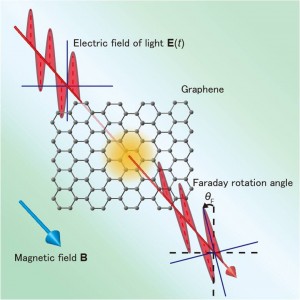Optical quantum Hall effect in graphene An exotic optical phenomenon exhibited by a “neutrino” (massless Dirac particle) in a solid.

Graphene is a monolayer sheet of carbon atoms bound in the form of a honeycomb lattice, for experiments on which a Nobel prize was awarded in 2010. Curiously, an electron in graphene behaves like a relativistic (Dirac) particle with zero mass (hence it has been dubbed a neutrino in a solid), and at about 1/300 times the speed of light, its velocity is high for a particle in a solid. Because of these exotic properties, graphene offers a unique arena in which to study the fundamental physics of condensed matter. It also has potential applications for next-generation high-speed electronic devices.

c Ryo Shimano. Schematic picture of magneto-optical Faraday rotation in graphene, a monolayer sheet of carbon atoms bound in the form of a honeycomb lattice. With an increasing magnetic field, the rotation angle was experimentally shown, for the first time, to exhibit a step-like rotation reflecting the half-integer quantum Hall effect even in the optical regime (optical quantum Hall effect) in graphene.
One of the most remarkable properties of graphene is the “half-integer” quantum Hall effect. When an electric field is applied to a sample perpendicular to an applied magnetic field, a (Hall) voltage emerges in a third direction perpendicular to both, termed the Hall effect. The Hall coefficient, which is the proportionality constant between the Hall voltage and the electric field, grows linearly with the magnetic field in classical physics. In a two-dimensional electron system in a strong magnetic field, however, the Hall coefficient is quantized into h/e2~25.8kΩ times over the reciprocals of integers (h: Planck’s constant, e: elemental charge), which is purely a quantum mechanical effect and material-independent. This is the well-known (integer) quantum Hall effect, which is nowadays used as the resistance standard. In graphene, the quantization occurs at half integers, which is a hallmark of a massless Dirac particle. As a result, it would be interesting to discover how the quantum features of Dirac electrons would appear in optical responses.
A group led by Associate Professor Ryo Shimano (Department of Physics, The University of Tokyo), in collaboration with Prof. Hideo Aoki in the same department, Dr. Hiroki Hibino (NTT Basic Research Labs) and Dr. Takahiro Morimoto (RIKEN) and their colleagues, have successfully measured the optical Hall effect using the magneto-optical Faraday and Kerr effects in the terahertz regime in a large-area graphene, epitaxially grown on a SiC substrate.
In the Faraday (or Kerr) effect, linearly polarized light passing through (or reflected by) a solid in a magnetic field is rotated, where the rotation angle is, normally, proportional to the magnetic field and the thickness of the material. In contrast, the rotation angle in graphene was shown to increase in jumps between the quantum Hall steps at half-integer values with a magnitude determined by the fine-structure constant, a fundamental physical constant. The result matches exactly with what is theoretically anticipated as the optical quantum Hall effect. This finding opens up new applications for graphene in optoelectronics such as use as an ultra-accurate and achromatic terahertz polarization rotator, in conditions more relaxed than usual (lower magnetic fields, higher temperatures).
Press release (Japanese)
Paper
R. Shimano, G. Yumoto, J. Y. Yoo, R. Matsunaga, S. Tanabe, H. Hibino, T. Morimoto, H. Aoki,
“Quantum Faraday and Kerr rotations in graphene,”
Nature Communications Online Edition: 2013/5/14, doi: 10.1038/ncomms2866.
Article link
Links
Department of Physics, Graduate School of Science
Shimano Laboratory, Department of Physics, Graduate School of Science






